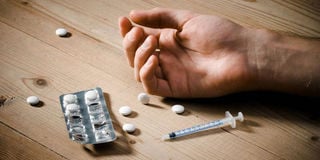Medics battling addiction need support, not judgment

It started as prescribed medication and ended up as full-blown addiction.
Jones* was heartbroken when he found out that he was not eligible to join medical school after secondary school.
However, Kenya was just starting to train nurses at degree level and Jones got into the pioneer class.
Four years later, Jones took the Nightingale Pledge and started work with utmost dedication. Within a few years, he was back to school studying to become a critical care nurse. He had found his calling.
Away from work, Jones spent his free time playing basketball at a local club. He had played for his secondary school team, but had been away from the game for quite a while. It felt good to be back in practice.
He also started dating a young doctor he met during his specialist training.
DARK PERIOD
Then one evening, during a basketball tournament, Jones suffered an injury and fractured his tibia and fibula, the bones of the leg. What followed was a dark period of excruciating pain and frustration at not being able to do the things he loved. He underwent surgery but had to remain in hospital for some time.
To manage his pain, he would receive opioid injection medication every eight hours.
The shots were a welcome relief as they suppressed the pain and knocked him out, allowing him to sleep away the endless hours.
When he went home, despite having adequate pain relief from the prescribed oral tablets, he struggled to sleep. Prescription sleeping pills didn’t give him the knock-out he wanted. He pleaded with his girlfriend to bring him prescription opioid injection medication to inject himself to sleep.
Five months after the injury, Jones was back to work. He was happy to get back to doing what he loved.
ADDICTION ROLLER-COASTER
However, despite healing well, the 12-hour shifts in the critical care unit were taxing. His leg would throb after work and he couldn’t wait to get home to put it up and rest.
He found himself sneaking in a shot of the opioids to alleviate the pain and sleep. Before Jones knew it, he was regularly injecting himself prescription medication to sleep.
He began pilfering the medication from the dangerous drugs locker in the critical care unit to meet his needs. What started as a medical need was turning into a monster that Jones was having trouble taming. He did not have the capacity to face up to the magnitude of the problem. The addiction roller-coaster had long taken off.
Suffice it to say, Jones never played basketball again. His relationship with his girlfriend hit the rocks and his supervisor caught up with his pilfering. Instead of a disgraceful dismissal. Jones was offered an opportunity to hand in his resignation.
The cycle of addiction is the same irrespective of the drug of addiction. A bright young nurse who was on the path to a bright future, was instead on a downward spiral to oblivion.
SLIPPERY SLOPE
Seven years of moving from one job to another, one seedy apartment to the next and losing friends and family eventually culminated in finally losing his license to practice for endangering patients’ lives.
There are many reasons why anyone would find themselves going down the slippery slope of addiction. Many are harshly judged, especially when they are hooked onto illegal substances.
For healthcare practitioners, the easy access to addictive prescription drugs easily fans the flames of addiction in record time.
Unfortunately, no one pays attention until things get out of hand, and in Kenya, there is no mechanism in place to deal with health workers who get into prescription drug abuse.
In the United States of America, there exists a robust physician health programme that is set up to support practitioners whose ability to practise safely is impaired. The impairment may be due to mental illness, cognitive impairment or drug addiction.
RISKS TO PATIENT CARE
The risk these practitioners pose to patient care cannot be underestimated. Nobody wants to be under anaesthesia and the doctor responsible for your life slumps in a corner from the effect of a pethidine shot he gave himself instead of you. Or to be that patient who is bleeding out, but the doctor’s hands are shaking too hard to put in the lifesaving cannula required to transfuse you. Or when your teenager is writhing in pain from a sickle cell crisis and the nurse has injected him with saline because she cannot account for the pethidine vial meant for him as she has already injected herself with it.
A health practitioner suffering addiction, and specifically prescription medication addiction, is not only a danger to himself, but is an even bigger danger to the patients. As we strive to take care of our patients struggling with addiction, we need to set up a system to ensure the same care is extended to our health workers. The system must work by providing a safe place for them to seek help without judgment.
We must also enable health workers to report their colleagues who may be unfit to practise due to addiction. However, the reporting should not be for punitive purposes but for enabling access to support and care. It is definitely time for a physician health programme in Kenya!
*Name has been changed



